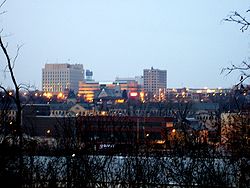Written by City of Appleton representatives.
Regardless of rising energy costs or the validity of human impact on global temperature changes, local governments owe it to their taxpayers and local communities to build and maintain facilities with a focus on energy efficiency, sustainability, and environmental quality that reduces operational costs that are paid by taxpayers. As stewards of the City of Appleton’s facilities and real property, the Facilities, Grounds, and Construction Management Department is committed to managing our facilities with this focus.

Historic Buildings on the Fox River
The City of Appleton maintains over 1.3 million square feet of facilities, 1.1 million square feet of parking structures, and 700 acres of grounds. The 15 largest city facilities accounted for over 23.1 million kWh and 866,000 therms during 2010. This is down considerably from our high of 24.1 million kWh and 1.06 million therms in 2008. Two of these facilities include a water plant and a wastewater plant which account for 75% of our utilities usage. Knowing this, much effort was targeted in lowering utility usage at the plants in conjunction with lowering utility usage at our other facilities.
In April of 2011 a bio-gas project at our wastewater plant will be completed and is anticipated to reduce energy usage by 300,000 therms. The project captures methane currently flared and uses it as a fuel in two boilers to meet the majority of heating needs at this campus.
Other significant projects include:
- Lighting upgrades performed, which commenced in 2006, account for a projected reduction of 1.6 million kWh.
- Retrocommissiong of the wastewater plant and library reduced electrical usage by 102,000 kWh and 54,000 therms annually.
- Converted to “green” cleaning chemicals and janitorial paper products carrying the “Green Seal” certification.
- Installed a networked computerized Energy Management and Control System in 14 of the largest buildings. Buildings can be monitored, controlled and scheduled from a single location or from remote locations. Cost savings are anticipated to result from decreased energy of 5% to 10%.
- Implemented an aggressive “Preventive Maintenance” program ensuring equipment is maintained to operate at optimal efficiency to decrease energy costs. ”Preventive Maintenance” includes oil, filter and belt replacements, tune-ups, testing, etc. to decrease the potential for break downs that cause down time and costly repairs.

- Replaced the original 120-ton chiller unit at the library with three 50 ton efficient chillers capable of being staged such that the air conditioning system will only use the chiller capacity needed, resulting in less energy used.
- Employed a multi-year program to install motion sensors on lighting systems resulting in lights coming on only when needed, and turning off when not needed.
- Integrating city automatic urinal flush valves with restroom lighting to ensure flushing only occurred when rooms are occupied, versus 24/7/365 operation.
- Performed air infiltration testing and improvements at a fire station which reduced the cubic feet per minute airflow by 35% for an anticipated energy savings of $4,984 annually. Air infiltration is air that can enter or leave a structure through unplanned penetrations in the exterior or roof of the structure.
- Track utilities expenses monthly and monitors trends. Train building occupants to create awareness and education for the responsible usage of energy.
- Developed a 5-year replacement plan for HVAC equipment replacements and upgrades of aging equipment. Equipment is replaced with energy efficiency and life-cycle cost justifications during purchase.
- Began installing white roofs and using light colored ballast as a sustainability initiative to reflect heat away from facilities during cooling months.
The City also understands that sustainability is much more than just energy reduction. For example, as the City performs demolition of the former Water Treatment Plant, we are taking every initiative to recycle or reuse materials. The project started with removing any materials that could be recycled and will conclude with grinding much of the concrete material and reusing it for fill.

The above initiatives focused on our efforts within our facilities, but the City has also had equal success towards sustainability in the areas of redevelopment, recycling, mass transit, use of alternative fuels, responsible chemical usage, storm water management, etc.
Mayor Hanna stated, “It is imperative that we plan for the future of our city in the decisions we make today. Reducing energy usage and dependency and preserving the earth’s natural resources not only reduces financial pressures paid by our citizens, but makes our city a better place to live for future generations.”
Fore more information about Appleton, please click here.
